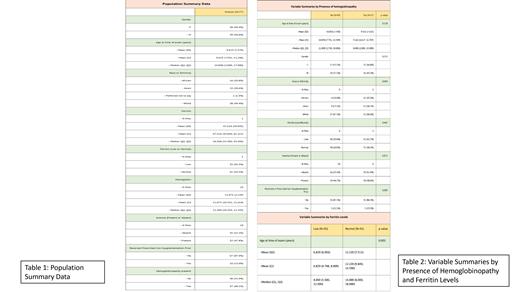Background
Low ferritin levels have been previously described to lower HbA 2 percentages on hemoglobinopathy evaluation. At our institution we have incorporated serum ferritin levels into an expanded panel test for thalassemia and hemoglobinopathy to assist with interpretation. There have been many critiques on the reference ranges used to define low ferritin in various pediatric ages. Lower ferritin levels, even in the absence of anemia or microcytosis, have been ascribed to nonspecific symptoms such as fatigue, weakness, difficulty concentrating, and decreased productivity that could be misconstrued as an attention-deficit disorder, especially in children. A hemoglobinopathy evaluation is often the first occasion for ferritin testing in patients; therefore, the hemoglobinopathy evaluation can serve as a key checkpoint to detect iron deficiency allowing for prompt treatment and amelioration of symptoms.
Objective
The purpose of this study was to evaluate the relationship between ferritin levels and the occurrence of hemoglobinopathies among pediatric patients in a single institution with the expectation that patients obtaining a hemoglobinopathy workup would be more likely to have a low ferritin (null hypothesis: there is no difference in the ferritin levels between patients receiving a hemoglobinopathy workup). The second hypothesis was that hemoglobinopathy testing would be done in a stepwise manner so at least 50% of patients obtaining a hemoglobinopathy workup would have prior interventions such as iron supplementation (null hypothesis: patients obtaining hemoglobinopathy evaluation have less prior interventions such as iron supplementation).
Design/Method
This retrospective, single center study included patients aged 0-18 years who had their first thalassemia and hemoglobinopathy testing for any indication between January 1, 2023 and July 28, 2023. Clinical variables were collected via review of the medical record. Low ferritin was defined as a ferritin level less than or equal to 25 mcg/L. Pearson's Chi Squared test and the Kruskal Wallis test were used for statistical analysis of categorical and continuous variables respectively.
Results
Seventy-seven total eligible patients were identified. Of those patients 35 were found to have low ferritin levels (45.5%). Among the patients with a low ferritin level, 15 patients also had a hemoglobinopathy present on their testing (41.7%) but there was no significant difference compared to those with normal ferritin levels (p value = 0.467). The patients with normal ferritin levels were of a significantly higher age compared to those with low ferritin levels 12.2 years vs 6.8 years (p value = 0.001) and 14 (42.4%) patients with low ferritin had no anemia and 29 (82.9%) never received prior iron supplementation. It was also noted that patients of Asian race were significantly more likely to have received prior iron supplementation 27.3% (p value = 0.004). Among patients with a hemoglobinopathy present the average age of their diagnosis was 9.1 years (95% Confidence Interval 6.6-11.7 years). Nine of the 10 patients with no hemoglobin values available were tested due to college sports participation and only 2 of those patients were found to have low ferritins.
Conclusion
Among our group of pediatric patients who underwent evaluation for thalassemia and hemoglobinopathy, there was no significant difference between those having a hemoglobinopathy present and lower or higher ferritin levels. Iron deficiency was more often noted among the younger patients even in the absence of anemia. It was important to note the majority of patients with iron deficiency detected on the hemoglobinopathy evaluation had never received prior iron supplementation until the time of their hemoglobinopathy evaluation. This also demonstrates that many providers may not do a stepwise workup but order all the evaluations at once. As there are many nonspecific symptoms of iron deficiency that can hinder the development of a child it is valuable to detect iron deficiency on hemoglobinopathy testing in order to intervene as soon as possible as iron deficiency can be masked by normal hemoglobin and normocytosis. Further investigation with larger study groups is warranted to better elucidate this relationship. Overall, our results suggest that enhanced characterization of iron deficiency parameters for patients receiving a hemoglobinopathy evaluation is warranted.
Disclosures
No relevant conflicts of interest to declare.


This feature is available to Subscribers Only
Sign In or Create an Account Close Modal